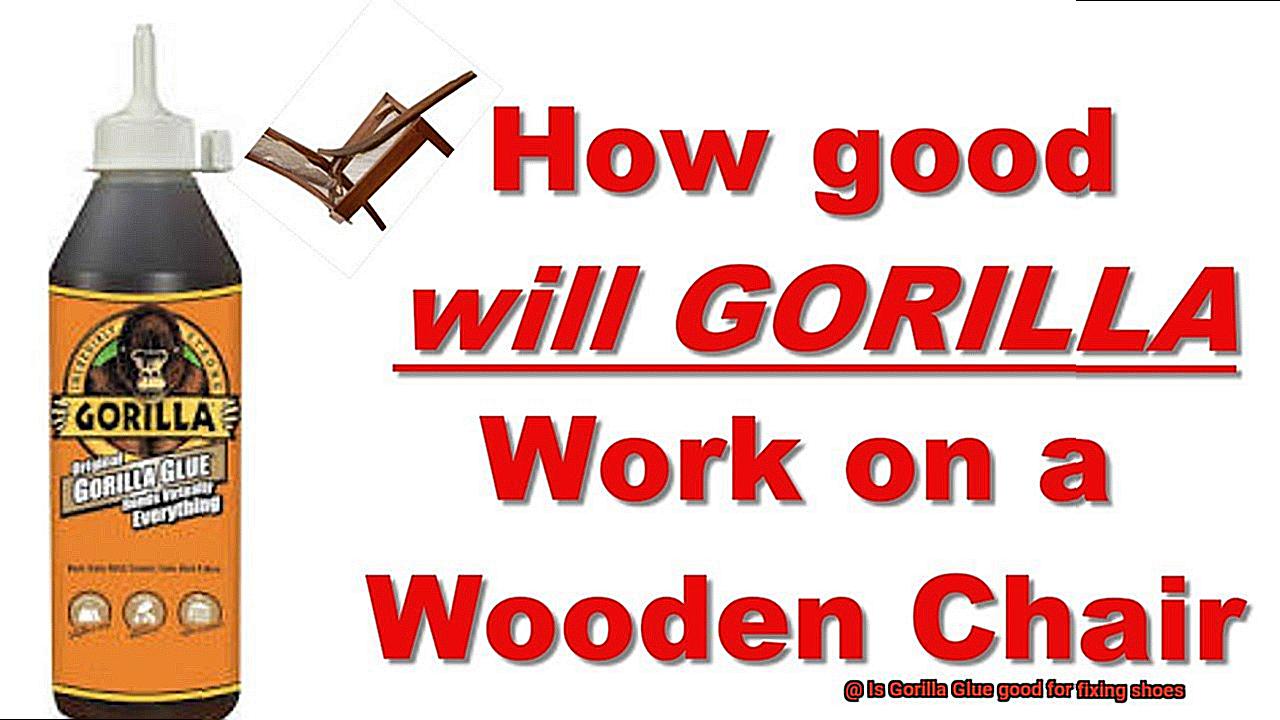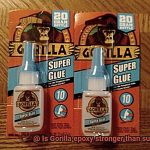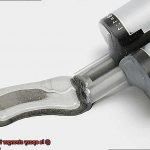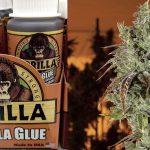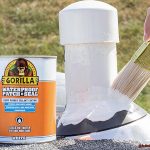Do you find yourself constantly replacing your shoes because they keep falling apart? Are you hesitant to take your favorite pair to a cobbler for an expensive repair? Well, have no fear. There may be a simple solution right in your own home – Gorilla Glue.
Gorilla Glue has become a household name due to its impressive bonding power. But can it really fix shoes? Many people have turned to this heavy-duty adhesive as a last resort, but does it actually work? And most importantly, is it safe?
In this blog post, we’ll delve into the world of shoe repair and explore the benefits and drawbacks of using Gorilla Glue for the job. We’ll examine which types of shoes are best suited for this type of repair, as well as the potential hazards and precautions that should be taken before using such a strong adhesive.
So whether you’re an avid DIY-er or simply looking for an affordable and trustworthy shoe repair option, read on to discover if Gorilla Glue is the answer you’ve been searching for.
Advantages of Using Gorilla Glue for Shoe Repair
Contents
- 1 Advantages of Using Gorilla Glue for Shoe Repair
- 2 Disadvantages of Using Gorilla Glue for Shoe Repair
- 3 How to Use Gorilla Glue for Shoe Repair
- 4 Tips for Using Gorilla Glue on Shoes
- 5 Alternatives to Gorilla Glue for Shoe Repair
- 6 When Not to Use Gorilla Glue for Shoe Repair
- 7 Pros and Cons of Using Gorilla Glue on Shoes
- 8 Conclusion
Here are the top advantages that make Gorilla Glue the perfect choice for fixing shoes:
Firstly, Gorilla Glue forms a bond that is incredibly strong and durable on almost any surface, including leather, rubber, and vinyl. Its unique polyurethane formula expands and fills gaps, creating a tight seal that holds up well under stress and pressure. This means that once you’ve repaired your shoes with Gorilla Glue, they will be able to withstand daily wear and tear without falling apart.
In addition to its strength, Gorilla Glue is also waterproof. This makes it an excellent choice for repairing shoes that may come into contact with water, such as rain boots or hiking shoes. Unlike other types of glue that may dissolve or become brittle when wet, Gorilla Glue remains strong and durable even when exposed to moisture.
Another advantage of using Gorilla Glue for shoe repair is its quick-drying time. The glue starts to dry within a few minutes of application and fully cures within 24 hours. This means you can wear your repaired shoes relatively quickly after applying the glue.
Gorilla Glue is also versatile and can be used for a variety of shoe repairs, including fixing soles, heels, and straps. It can even be used to attach embellishments or decorative elements to shoes. This makes it a cost-effective solution for minor repairs that would otherwise require expensive professional assistance.
Finally, Gorilla Glue has a long shelf life and can last for years if stored correctly. This means that you can keep it on hand for future shoe repairs without worrying about it going bad or losing its effectiveness.
In conclusion, using Gorilla Glue for shoe repair has numerous benefits that make it the go-to choice for DIY enthusiasts. Its strength, waterproofing capabilities, quick-drying time, versatility, and longevity make it an excellent choice for repairing shoes at home. However, it is important to use Gorilla Glue sparingly and carefully when repairing shoes to avoid discomfort or affecting the overall fit of the shoe.
Disadvantages of Using Gorilla Glue for Shoe Repair
When it comes to repairing shoes, Gorilla Glue may not be the best option, despite its popularity as a versatile adhesive. Using Gorilla Glue for shoe repair comes with several disadvantages that could lead to an unsightly and uncomfortable outcome.
One of the main disadvantages of using Gorilla Glue for shoe repair is its expanding nature. As it dries, the glue expands, causing the sole to detach from the upper part of the shoe, leaving an unappealing gap. This gap could also lead to discomfort while walking, making it less than ideal for shoe repair.
Furthermore, shoes undergo a lot of wear and tear, and any glue used for their repair should be able to withstand this stress. However, Gorilla Glue tends to become brittle over time, leading to cracks and breakages when exposed to constant flexing and bending.
Another disadvantage of using Gorilla Glue for shoe repair is its inability to withstand water exposure. Shoes often come into contact with water, especially during rainy weather or when walking through puddles. If Gorilla Glue is used for shoe repair, any exposure to water can cause it to break down and lose its adhesive properties, leading to a failed repair.
Removing Gorilla Glue from shoes can also be a difficult and messy task due to its strong bonding with most materials. Attempting to remove it could cause unsightly marks and damage that may not be easy to repair.
How to Use Gorilla Glue for Shoe Repair
Don’t fret. With the right tools and techniques, you can repair them and extend their lifespan. Gorilla Glue is a popular adhesive that many people use for shoe repair. However, it’s crucial to use it correctly to ensure the best results. Here are some expert tips on how to use Gorilla Glue for shoe repair:
Prepare the area

The key to a successful shoe repair is preparation. Before applying Gorilla Glue, ensure that the area is clean and free of any dirt, dust, or debris. You can use a shoe cleaner or soap and water to clean the area and allow it to dry completely. If necessary, use sandpaper or an abrasive material to roughen the surface for better adhesion.

Apply the glue
Once the area is prepped, it’s time to apply Gorilla Glue. Use a small amount of glue and apply it directly onto one of the surfaces that needs bonding together. Avoid using too much glue as excess glue can expand and create a mess.
Press together
After applying the glue, press the two surfaces together firmly and hold them in place for at least 10-20 seconds. Applying consistent pressure during this time will ensure that the bond is strong.
Let it dry
Allow the glue to dry completely, which typically takes about 24 hours. Avoid touching or moving the shoe until the glue has fully cured.
Trim excess glue
After the glue has dried, any excess glue can be trimmed away with a sharp knife or scissors. This step is important as excess glue can harden and become uncomfortable when wearing the shoes.
It’s important to note that Gorilla Glue dries to a tan color, which may not be suitable for lighter-colored shoes. Additionally, while Gorilla Glue can be a good option for minor shoe repairs, it may not be enough for more complex repairs or replacements. In such cases, it’s best to consult a professional cobbler or shoemaker.
Tips for Using Gorilla Glue on Shoes

Gorilla Glue is an excellent adhesive for fixing minor shoe repairs, but it’s important to follow some essential tips to ensure a successful repair. By preparing the surface, using Gorilla Glue sparingly, clamping the glued area, letting the glue dry completely, and storing it properly, you can extend the life of your shoes in no time.
Prep the Surface
The first step to a successful shoe repair is to prepare the surface. Cleaning any dirt or debris from the surface and ensuring it’s completely dry before applying the glue is crucial. A clean and dry surface allows for better adhesion and creates a stronger bond.
Use Gorilla Glue Sparingly
It’s essential to use Gorilla Glue sparingly. Applying a thick layer of glue can weaken the bond and cause it to expand beyond the intended area. Start with a small amount of glue and use a toothpick or other small tool to spread it evenly over the surface.
Clamp or Press the Glued Area Together
Clamping or pressing the glued area together until the glue has fully cured is crucial. This process can take anywhere from a few hours to overnight, depending on the type of Gorilla Glue being used. Using clamps or heavy books can help ensure a strong bond and prevent any shifting or misalignment.
Let the Glue Dry Completely
After holding the glued area together for at least 20-30 seconds, let the glue dry completely before using the shoe again. This process can take several hours or even overnight, depending on how much glue was applied. It’s essential not to rush this step as it can compromise the strength of the bond.
Store Gorilla Glue Properly
Proper storage is essential for prolonging Gorilla Glue’s shelf life and ensuring that it’s ready to use when needed. Keeping it in a cool and dry place will prevent it from drying out or becoming too thick, ensuring it’s in good condition the next time you need it.
Alternatives to Gorilla Glue for Shoe Repair
While Gorilla Glue may be the most well-known adhesive for shoe repair, there are several alternatives to consider depending on the type of repair needed and the materials being used. Here are five options to consider:
First up is Shoe Goo, a specially designed adhesive for shoe repair. It dries clear and flexible, making it perfect for repairing soles and other parts of the shoe that move a lot. However, it may not be as strong as other adhesives, so multiple applications may be necessary for larger repairs.
Next is Epoxy, a two-part adhesive that creates a strong bond but may not be as flexible as other adhesives. It’s important to keep in mind that it can crack over time with repeated use.

If you’re in a pinch, Superglue forms a fast-drying, strong bond. However, it’s not ideal for larger repairs or areas that experience a lot of movement. Plus, it can be difficult to remove if you make a mistake during application.
For a rubber-based adhesive that creates a strong, permanent bond, there’s Contact cement. It’s often used in shoe repair and can be used on both porous and non-porous materials. However, it can be messy to work with and has a strong odor.
Finally, there’s hot glue. While it can be used for shoe repair, it may not hold up as well over time as other adhesives. It’s best used for temporary fixes or in conjunction with other adhesives.
When Not to Use Gorilla Glue for Shoe Repair
We all love our shoes and want to keep them in the best possible condition. When it comes to shoe repair, Gorilla Glue is a popular choice, but it’s essential to know when not to use it. As an expert in shoe repair, I’m here to share some crucial tips on when to avoid using Gorilla Glue for shoe repair.
Firstly, let’s talk about shoes made of flexible materials such as leather or fabric. Gorilla Glue may not be the best option for these shoes as it dries hard and can become brittle over time. As a result, it may not withstand the constant bending and flexing that occurs with these types of materials.
Secondly, if you need to repair shoes that will be exposed to water or moisture regularly, Gorilla Glue may not be sufficient. Although Gorilla Glue is known for its strong adhesive properties, it is not entirely waterproof. You should consider using a different type of adhesive specifically designed for waterproofing.
Moreover, precision repairs can be challenging with Gorilla Glue as it expands as it dries, making it challenging to control the amount of glue applied. If you need to make a precise repair on your shoes, choose a different type of adhesive that allows for more control.
Lastly, if you’re looking for a quick fix, Gorilla Glue may not be the best option. While it has a strong and long-lasting hold, it takes some time for the glue to dry and set properly. Therefore, you may want to consider an adhesive that dries more quickly.
Pros and Cons of Using Gorilla Glue on Shoes
If you’re in search of a quick and easy fix for your favorite pair of shoes, you might be considering using Gorilla Glue. While this popular adhesive can be useful for a wide range of DIY projects, it’s important to understand the pros and cons of using Gorilla Glue on shoes before diving in.
Pros:
- Strength: Gorilla Glue is renowned for creating a strong and durable bond, making it an excellent choice for fixing shoes that are worn down or damaged. This adhesive can handle wear and tear like a champ, providing long-lasting repairs.
- Waterproof: When applied correctly, Gorilla Glue is water-resistant, which means it can help protect your shoes from moisture damage. This can be especially useful if you live in a rainy climate or frequently find yourself walking through puddles.
Cons:
- Lack of Flexibility: While Gorilla Glue is strong, it’s also inflexible. When applied to a shoe, the glue can become brittle over time and may crack as the shoe bends and flexes during use. This could lead to repeated repairs or even permanent damage to the shoe.
- Curing Time: Unlike some other types of glue that dry quickly, Gorilla Glue takes several hours to cure completely. This means that you’ll need to wait patiently before using the shoe again, which could be inconvenient if you’re in a rush.
- Challenging to Remove: Gorilla Glue can be incredibly difficult to remove from surfaces where it shouldn’t be. If you accidentally get some on your clothing or furniture while repairing your shoes, you could end up with permanent damage.
Conclusion
In conclusion, Gorilla Glue can work wonders when it comes to fixing shoes. However, before you dive in and start using it, it’s important to weigh its pros and cons.
On the plus side, this glue is a powerhouse that boasts strength, waterproofing capabilities, quick-drying time, versatility and longevity. DIY enthusiasts swear by it for good reason.
But don’t let its impressive qualities fool you into thinking that Gorilla Glue is perfect for every shoe repair job. Its expanding nature can cause discomfort and unsightly gaps in your shoes.
Plus, it may not be ideal for flexible materials or precision repairs.
To make the most of Gorilla Glue for shoe repair purposes, there are several key steps to follow. You should prepare the surface properly, use the glue sparingly and clamp or press the glued area together until it dries completely. Storing your repaired shoes correctly will also help them last longer.
If you’re looking for alternatives that offer more flexibility or better waterproofing abilities than Gorilla Glue does, then Shoe Goo or Contact cement might be more suitable options for you.
Ultimately, whether or not Gorilla Glue is right for your specific shoe repair needs depends on various factors such as the type of shoe and repair required.
For complex repairs involving flexible materials like leather or fabric, seeking professional help from a cobbler or shoemaker could be your best bet.

